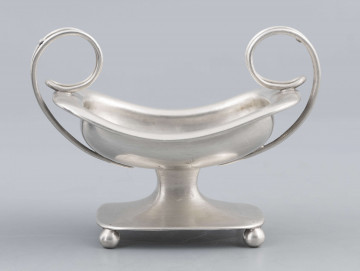
Salt cellar
1839 — 1850
National Museum in Lublin
Part of the collection: Craft and industry products of Szczecin
In the first half of the 19th century, European goldsmithing began to undergo a transformation connected with mechanisation of manufacturing. The possibility of relatively inexpensive production of silver objects from thin, die-cut sheet metal contributed to the popularity of silverware among the burghers. Companies made coffee and tea services, spice containers, cutlery and various kinds of platters and baskets for cakes and fruit. The residents of Szczecin readily bought and used them. Many of these products were supplied by the local goldsmith and jeweller Carl Albert Friedrich (1796-1875), who inherited the silverware factory from his father. He received civic rights in 1820 and served as a city councillor in 1837-1864. Many of Szczecin’s homes had tableware manufactured in his factory, including the popular spatula – a knife for cutting fish, with a characteristic asymmetrical cut and openwork cut-outs, which were necessary to drain excess fluids. Carl Albert Friedrich was also the author of many pieces of church furnishings installed in churches in Szczecin.
Anna Lew-Machniak
Author / creator
Dimensions
cały obiekt: height: 29 cm
Object type
fish spatula, accessories
Creation time / dating
Creation / finding place
Identification number
Location / status

1839 — 1850
National Museum in Lublin

1832 — 1850
National Museum in Lublin

1832 — 1850
National Museum in Lublin
DISCOVER this TOPIC
Castle Museum in Łańcut
DISCOVER this PATH
Educational path